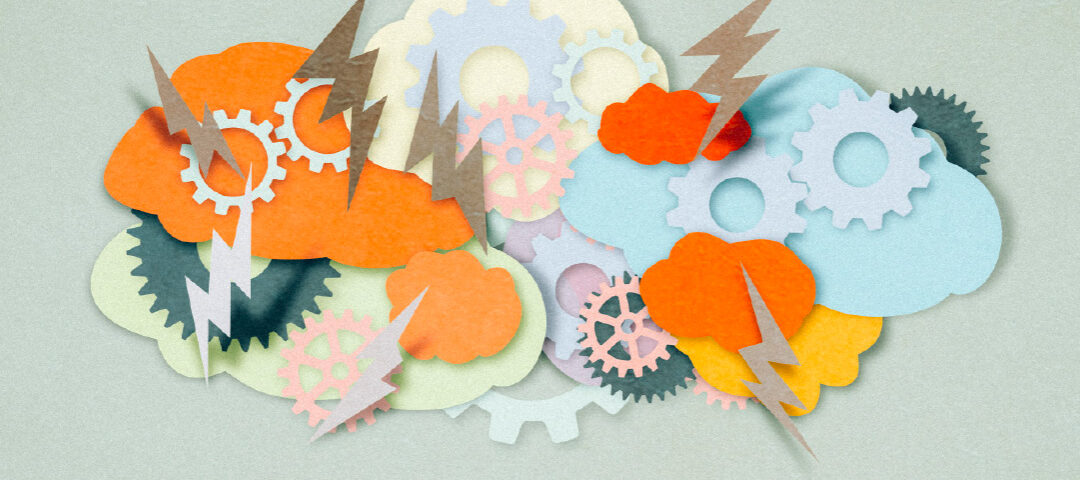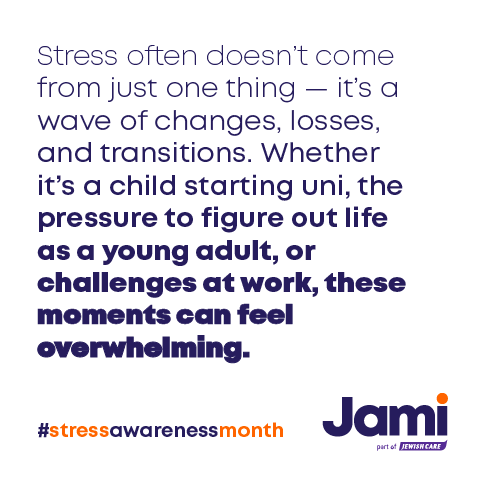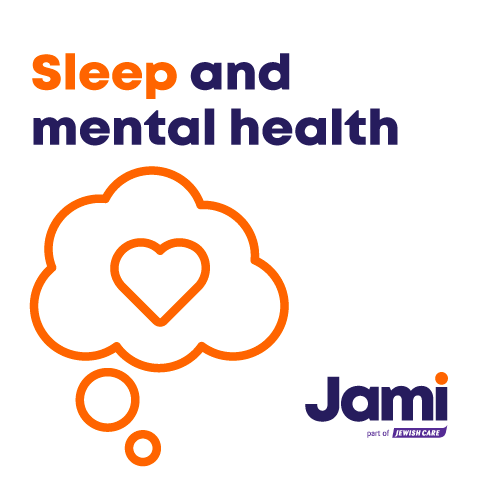
This article was written by Kooth, the digital platform that delivers Jami Qwell online counselling.
The science of stress
Stress can be overwhelming. It comes up a lot in our busy world, and we’re all likely to feel stressed at some point in our lives. In this article, we’re going to be looking at what happens in our brains when we’re faced with a stressful situation and the physical changes that we then experience in our bodies as a result.
What is stress?
When we’re faced with a stressful situation – such as giving a presentation, attending a medical appointment, or organising a meeting – our brains immediately begin to release chemicals to prepare the body to deal with whatever is causing the stress. Our senses send a message to a part of the brain called the amygdala, which is the part responsible for keeping us safe.
For example, if we were to see a tiger walking towards us, then the special sensors in our eyes would send a signal to the amygdala – like when your smoke detector senses smoke and sends a message to the alarm. The amygdala then sends a signal to another part of the brain, called the hypothalamus. This signal is like an alarm, intended to wake the hypothalamus up and make it focus on getting us to safety.
You can think of the hypothalamus as the command centre of the brain – it communicates with the nervous system, which runs through our entire bodies. When you stub your toe, it is the nervous system that sends a signal to the brain telling it that it hurts. This signal goes through the hypothalamus. When the amygdala sends the alarm signal to the hypothalamus, the hypothalamus activates something called the “sympathetic nervous system”.
Imagine the amygdala as a space ship captain who has just declared red alert, and the hypothalamus is the bridge, or control centre, of the ship. From the control centre, the crew can divert power to the weapons and shields, or to the engines, to prepare the ship to either fight or run away, as necessary.
You can think of the sympathetic nervous system like the ship’s power or energy – it uses it to prepare the ship for danger, just like the sympathetic nervous system prepares us. It does this by sending signals to the adrenal glands, which respond by releasing adrenaline into the bloodstream, like power being released to the ship’s shields.
All of this happens so quickly that you don’t even know it’s happening – that’s why we’re able to respond immediately when we see a ball flying towards us.
When people experience chronic stress (in other words, when they continue to feel stressed, sometimes for hours or days at a time), it is due to the second part of the stress response network, the HPA Axis.
The HPA Axis is there to help keep us safe if the danger is more than just a ball. Think about when we watch a horror film, for example; even if nothing frightening is happening onscreen, we are extra alert, because our HPA Axis keeps us ready in case something does happen. However, if the HPA Axis doesn’t switch off, it can quickly become exhausting, as it will keep our senses extra sharp, listening and looking for danger everywhere. This is why we often feel very tired after a stressful experience. And, if the HPA Axis rarely switches off, then we experience chronic stress.
This is usually what happens when you think about bills or a presentation, as the threat is not as immediate as the threats we were evolved to face (like wild animals, for example), but your amygdala continues to send alarm signals to the hypothalamus. The adrenaline in the bloodstream brings about a number of changes in the body, and these are what we’ll look at next.
Stress and the body
When the adrenaline gets into your blood, it starts to make changes that you will immediately be able to feel. It opens the small passageways of the lungs so that you can breathe more easily, getting more oxygen to fuel your body. Your blood starts to flow more towards your muscles and heart, so that you can run or fight better. Your sight and hearing also becomes sharper, in order to detect threats more easily.
You might be wondering why your body would do all this at the sight of an envelope from the bank – after all, as frightening as they can be, bills aren’t a physical threat in the same way a tiger is. The reason is because our bodies are still wired the same as our caveperson ancestors. To our brains, a threat is a threat, whether that’s a big tiger running towards us while we’re hunting for food or an unpleasant overdraft bill from our bank.
That means our brains will try and keep us safe the same way – often by attempting to either fight the bill or to run away from it. That’s why it’s important to practice soothing techniques, which we’ll look at below, to help remind our brains that we’re not facing a tiger, and it can relax.
If, however, your body continues in this state for too long, it can lead to physical as well as mental health issues. Frequent surges of adrenaline can lead to high blood pressure, as your body is constantly trying to prepare you to face a danger that may no longer exist, and high blood pressure can lead to a whole range of other health problems.
That’s why it’s important to try to soothe ourselves when we feel stressed, either by confronting the cause, or, if there doesn’t appear to be an obvious cause, by talking to someone or taking some time to practise self-care.
Tackling Stress
Once the threat has passed, the hypothalamus triggers something called the “parasympathetic nervous system” – think of it like the brakes that stop stress from running out of control. Imagine you’ve escaped from the tiger we mentioned earlier – your eyes are no longer sending the amygdala images of a tiger, and your ears aren’t sending it sounds of a tiger growling, so the parasympathetic nervous system kicks in and tells your legs to stop running, because you’re safe now.
This system also stops adrenaline being released and allows the body to slowly begin winding down to its pre-stress levels of activity. This is important, as we mentioned earlier, as long-term stress can be quite bad for you.
But, as we talked about before, sometimes the brain can’t tell if the thing causing the stress has passed. Because the amygdala is focussed on protecting us, it keeps us on alert mode until it can be sure there’s no danger. This is what causes some people to feel stressed all the time.
Think back to a time, for example, when you had an argument with someone, and even after the argument was over, you continued to feel stressed. This was because your amygdala was worried that there might still be a threat, and so kept your body prepared to face danger, just in case.
Fortunately, there are some things we can do to show the amygdala there is no danger and convince it to reset:
- Deep Breathing has been shown to be highly effective at countering the body’s stress response systems.
- Physical Activity can also be a good way to help use up the energy that’s created when the body goes into fight or flight mode and bring us back to a more relaxed state. It doesn’t work for everyone, though, and it’s important to set sensible goals and recognise your achievements.
However, if you do choose to do some physical activity when stressed, it is important to be aware of how your body is feeling, and if you notice while you exercise that you’re starting to feel more stressed, you should stop and try something soothing instead, as exercising too much while stressed can make you unwell.
- Social Support can help us to feel safer and therefore calm us down when we’re stressed. Even just a reassuring touch on the shoulder from someone we care about causes our brains to release oxytocin, also known as “the love hormone”, which helps to soothe the stress response, particularly helping to relax the heartbeat.
There is also research to show that even talking to people who you have a strong connection to can help and, if you can’t hug a friend, hot water bottles or weighted blankets can have a similar effect.
Where can you look for extra support?
Jami is the mental health service for the Jewish Community. If you need support or are supporting someone who needs help, visit https://jamiuk.org/get-support/ or contact 020 8458 2223.
If you are struggling to cope or need immediate help, contact Shout’s 24/7 crisis text service. Text Jami to 85258 for free, confidential support.
For free, safe and confidential online counselling and emotional wellbeing services for adults, contact Jami Qwell at https://www.qwell.io/jami


